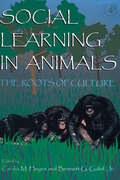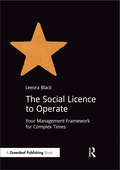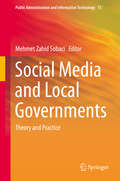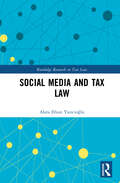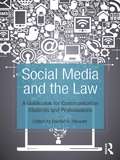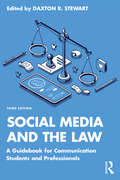- Table View
- List View
Social Learning In Animals: The Roots of Culture
by Bennett G. Galef Jr. Cecilia M. HeyesThe increasing realization among behaviorists and psychologists is that many animals learn by observation as members of social systems. Such settings contribute to the formation of culture. This book combines the knowledge of two groups of scientists with different backgrounds to establish a working consensus for future research. The book is divided into two major sections, with contributions by a well-known, international, and interdisciplinary team which integrates these growing areas of inquiry.Integrates the broad range of scientific approaches being used in the studies of social learning and imitation, and society and cultureProvides an introduction to this field of study as well as a starting point for the more experienced researcherChapters are succinct reviews of innovative discoveries and progress made during the past decadeIncludes statements of varied theoretical perspectives on controversial topicsAuthoritative contributions by an international team of leading researchers
Social Legitimacy in the Internal Market: A Dialogue of Mutual Responsiveness (Modern Studies in European Law)
by Jotte MulderThis book is concerned with the social legitimacy of internal market law. What does social legitimacy entail within the multi-level 'embedded liberalism' construction of the internal market? How can the objectives of the internal market that focus on economic rights and a commitment to social diversity both be pursued without one necessarily trumping the other? These questions continue to challenge the very core of European integration. How can the diversity of Member States' 'social systems' and the varying normative infrastructure of their economies be sustainably accommodated within the internal market? This book seeks to contribute to these questions by discussing what has come to be known as the argument from transnational effects and the development of an adjudicative model for the European Court of Justice that can be termed 'socially responsive'. Drawing on the historical insights of Karl Polanyi it argues that the internal market can only be held to be socially legitimate where it supports the requirement for further market integration while still responding to social practices and values within the member states. The book presents in-depth studies of the case law of the Court in the areas of EU free movement, competition and state aid law. In so doing, this important new study aims to provide the language and tools for assessing social legitimacy in the internal market.
Social Legitimacy in the Internal Market: A Dialogue of Mutual Responsiveness (Modern Studies in European Law)
by Jotte MulderThis book is concerned with the social legitimacy of internal market law. What does social legitimacy entail within the multi-level 'embedded liberalism' construction of the internal market? How can the objectives of the internal market that focus on economic rights and a commitment to social diversity both be pursued without one necessarily trumping the other? These questions continue to challenge the very core of European integration. How can the diversity of Member States' 'social systems' and the varying normative infrastructure of their economies be sustainably accommodated within the internal market? This book seeks to contribute to these questions by discussing what has come to be known as the argument from transnational effects and the development of an adjudicative model for the European Court of Justice that can be termed 'socially responsive'. Drawing on the historical insights of Karl Polanyi it argues that the internal market can only be held to be socially legitimate where it supports the requirement for further market integration while still responding to social practices and values within the member states. The book presents in-depth studies of the case law of the Court in the areas of EU free movement, competition and state aid law. In so doing, this important new study aims to provide the language and tools for assessing social legitimacy in the internal market.
Social Licence and Ethical Practice (Research in Ethical Issues in Organizations #27)
by Hugh BreakeyWhat is the social licence to operate, and what are its ethical risks and promises? This collection explores these questions from a range of perspectives. Since its first key uses in the late 1990s in application to operational risks for extraction industries, the idea of the ‘social licence to operate’ has proliferated. It has since been applied to myriad industries—including tourism, paper milling, banking, and aquaculture—and even to the work of scientists and government agencies. Yet what is the ethical status of this concept? It is easy to assume that the social licence to operate is a welcome tool to improve the ethics of profit-seeking enterprises, forcing them to genuinely respond to community and stakeholder concerns, or face operational risk if they do not. No doubt the social licence sometimes—perhaps even often—works in this way. Yet there is ethical risk as well as promise in the social licence. For the concept can be weaponised by stakeholders, taking operational legitimacy out of the hands of settled law and democratic institutions, and wedding it to shifting community attitudes. Conversely, the concept can be used as a rhetorical shield by industry, who can insist they possess a social licence even when engaging in fraught ethical practice. These conflicting uses give rise to a separate worry: that the social licence is too ambiguous to function as anything but a meaningless buzzword, a distraction from high ethical standards and strong governance regimes. This Collection interrogates these challenges, exploring in a range of contexts whether and how the social licence’s ethical promise can be secured, and its risks mitigated.
Social Licence and Ethical Practice (Research in Ethical Issues in Organizations #27)
by Hugh BreakeyWhat is the social licence to operate, and what are its ethical risks and promises? This collection explores these questions from a range of perspectives. Since its first key uses in the late 1990s in application to operational risks for extraction industries, the idea of the ‘social licence to operate’ has proliferated. It has since been applied to myriad industries—including tourism, paper milling, banking, and aquaculture—and even to the work of scientists and government agencies. Yet what is the ethical status of this concept? It is easy to assume that the social licence to operate is a welcome tool to improve the ethics of profit-seeking enterprises, forcing them to genuinely respond to community and stakeholder concerns, or face operational risk if they do not. No doubt the social licence sometimes—perhaps even often—works in this way. Yet there is ethical risk as well as promise in the social licence. For the concept can be weaponised by stakeholders, taking operational legitimacy out of the hands of settled law and democratic institutions, and wedding it to shifting community attitudes. Conversely, the concept can be used as a rhetorical shield by industry, who can insist they possess a social licence even when engaging in fraught ethical practice. These conflicting uses give rise to a separate worry: that the social licence is too ambiguous to function as anything but a meaningless buzzword, a distraction from high ethical standards and strong governance regimes. This Collection interrogates these challenges, exploring in a range of contexts whether and how the social licence’s ethical promise can be secured, and its risks mitigated.
The Social Licence to Operate: Your Management Framework for Complex Times
by Leeora BlackThe "social licence to operate" began as a metaphor to bring attention to the need for companies to earn acceptance from their host communities. Today, it is a necessary management framework for complex times.A social licence strategy is essentially a stakeholder engagement strategy for navigating complex socio-political environments. This book provides the framework, tools and case studies a company needs to create a foundation for truly sustainable community development.This 90-minute guide will enable you to: define the social licence to operate; make the business case for actively managing your social licence to operate; measure the social licence to operate; develop a step-by-step plan to restore, build, maintain and enhance your company’s social licence; and report on your social licence.This book is for managers in any company facing rising social scrutiny due to unwanted social or environmental impacts. You may be working in natural resources, renewable energy, oil and gas, forestry, construction, manufacturing, retail, food processing, pharmaceuticals or any industry that is facing rising stakeholder expectations and increasing criticism.
The Social License: The Story of the San Cristobal Mine
by Robert Boutilier Ian ThomsonThis unique book combines a colourful history of Bolivian politics with some of the most advanced quantitative techniques yet developed for socio-political risk analysis. This is the story of how a foreign-owned private sector mining company (Minera San Cristobal - MSC) earned, lost, and regained its social licence to operate. Robert G. Boutilier and Ian Thomson, leading experts in stakeholder management theory and practice, transform the concept of the SLO from a metaphor to a management tool. The book traces the development of new concepts and measures in the field of stakeholder engagement while following the narrative of a community struggling with a fundamental change in its identity from a declining, malnourished llama-herding village to one of the richest towns in Bolivia. This remarkable story will inspire practitioners in the field of stakeholder management; it will provide an invaluable roadmap for professionals working on land re-use projects in the energy, mining, and conservation sectors; it will make stakeholder relations concepts and techniques accessible to students through an engaging and in-depth case study; and it will open your eyes to one of the most fascinating accounts of how two different cultures collided and then came together to address different but aligned goals.
The Social License: How to Keep Your Organization Legitimate
by John MorrisonA distinctive and direct guide to legitimacy in business, focusing on the new benchmark of a 'Social License to Operate'. Featuring case studies of what is and isn't working, this book explains how business owners and CSR professionals can integrate legitimacy into the heart of their company strategy, beyond CSR and good PR.
The Social License: The Story of the San Cristobal Mine
by Ian Thomson Robert BoutilierThis unique book combines a colourful history of Bolivian politics with some of the most advanced quantitative techniques yet developed for socio-political risk analysis. This is the story of how a foreign-owned private sector mining company (Minera San Cristobal - MSC) earned, lost, and regained its social licence to operate. Robert G. Boutilier and Ian Thomson, leading experts in stakeholder management theory and practice, transform the concept of the SLO from a metaphor to a management tool. The book traces the development of new concepts and measures in the field of stakeholder engagement while following the narrative of a community struggling with a fundamental change in its identity from a declining, malnourished llama-herding village to one of the richest towns in Bolivia. This remarkable story will inspire practitioners in the field of stakeholder management; it will provide an invaluable roadmap for professionals working on land re-use projects in the energy, mining, and conservation sectors; it will make stakeholder relations concepts and techniques accessible to students through an engaging and in-depth case study; and it will open your eyes to one of the most fascinating accounts of how two different cultures collided and then came together to address different but aligned goals.
Social Management: Principles, Governance and Practice (CSR, Sustainability, Ethics & Governance)
by Giuseppe ArgiolasThis book presents a new governance framework for socially oriented business management. It offers a detailed and comprehensive analysis of socially oriented business and its key stakeholders, and introduces a managerial model that is both sustainable in the long term and effective. The book first provides an overview of these organizations and compares the most common managerial systems. It then introduces the concept of Corporate Social Responsibility, and explains the fundamentals for action by and within the business. Based on this framework, it develops an integrated approach for the management of the socially oriented enterprise and explains the interplay between the central drivers for this management model and how to put the model into practice. The book is a valuable resource for graduate and advanced undergraduate courses in sustainable management.
Social Management Responsiveness in Business (Emerald Points)
by Cesar SaenzA lot of controversy exists around the contribution of the mining industry and the territorial development of the regions where it operates. Despite the boom in mineral prices, there are still many communities that do not show development. At the macroeconomic level, countries with a mining industry receive income from mining taxes and royalties, however, at the micro level this greater income is not reflected in the closing of socio-economic gaps and the well-being of the population. Cesar Saenz presents the Social Management Model Canvas (SMMC), describing the rationale of how an extractive company can create and deliver social value for communities around and beyond the sphere of influence. The SMMC can best be described through nine basic building blocks - the social value proposition; defining the community; social channels; relationship with the community; key social resources; key social activities; key social partners; social investment structure and social benefits. Companies can map the existing social management model to visualize, understand and communicate the level of responsiveness of the model, whilst using the canvas to explore new social management improvements to get a social license to operate. Communities require companies and governments to address their needs such as education, employment, health service, among others. Combining all these elements in a social management model helps companies consider all the variables when designing and implementing strategies that meet both business and community needs.
Social Management Responsiveness in Business (Emerald Points)
by Cesar SaenzA lot of controversy exists around the contribution of the mining industry and the territorial development of the regions where it operates. Despite the boom in mineral prices, there are still many communities that do not show development. At the macroeconomic level, countries with a mining industry receive income from mining taxes and royalties, however, at the micro level this greater income is not reflected in the closing of socio-economic gaps and the well-being of the population. Cesar Saenz presents the Social Management Model Canvas (SMMC), describing the rationale of how an extractive company can create and deliver social value for communities around and beyond the sphere of influence. The SMMC can best be described through nine basic building blocks - the social value proposition; defining the community; social channels; relationship with the community; key social resources; key social activities; key social partners; social investment structure and social benefits. Companies can map the existing social management model to visualize, understand and communicate the level of responsiveness of the model, whilst using the canvas to explore new social management improvements to get a social license to operate. Communities require companies and governments to address their needs such as education, employment, health service, among others. Combining all these elements in a social management model helps companies consider all the variables when designing and implementing strategies that meet both business and community needs.
Social Media and Employment Law: An International Survey
by Anders Etgen Reitz Jan Rudolph Philip M. BerkowitzIn the last few years, social media has become the primary way of communicating, not only among friends and colleagues but also between employers and employees and between companies and consumers. For employers, the phenomenon offers great opportunities, but also concomitant dangers due primarily to use of social media by employees and employees' representatives. Written in the context of employment laws as well as privacy laws, this book surveys the state of the law in over thirty key jurisdictions, including most of the developed countries of Europe, Asia, and North America and major developing countries worldwide. The publication arose from a seminar prepared by the editors and others at which it was clearly identified that internationally operating employers need a comprehensive and user-friendly multinational summary on employment and labour law questions arising in connection with the use of social media. The book is divided into country chapters, each written by a known local specialist. In order to easily 'navigate' through the issues for each country, the chapters follow a uniform structure, covering the applicable statutory regimes, case law, useful checklists, and recommendations. Among the issues and topics dealt with are the following: - employees' entitlement to use social media at the workplace; - whether employers can require the use of social media by employees; - right of employers to monitor employees' use of social media outside the workplace; - employers' potential liability for employees' misuse of social media; - right of employee representatives to use employers' equipment for social media purposes; - employers' remedies against misuse of social media by employees and employee representatives; - development and drafting of a social media policy; and - role of social media in employer–employee disputes. No other publication exists providing interested parties with a practical and strategic guide to legal issues affecting the use of social media in the workplace. With its easy-to-use country-by-country format and its expert recommendations, this unique resource will prove itself as an incomparable handbook for lawyers, human resources professionals, and in-house counsel advising or working for internationally operating businesses. It will also be of inestimable value for academics and policymakers concerned with the legal ramifications of social media use in the workplace.
Social Media and Law Enforcement Practice in Poland: Insights into Practice Outside Anglophone Countries (Routledge Studies in Crime, Culture and Media)
by Paweł WaszkiewiczThis book explores the role of social media in the daily practice of Polish criminal justice and how social media is, in turn, reshaping this practice. Based on empirical research, it confronts common beliefs about how police officers, prosecutors, and judges use social media in their work. Readers will find answers to the following questions: Which social media platforms are popular among law enforcement officers in Poland? How do the police use social media to investigate and prosecute crimes? What are the strategies for using social media to communicate with the community? What strategies are most successful?The findings in this book challenge some popular beliefs and theories about social media in criminal justice. As the first book to explore the use of social media in criminal justice outside of English-speaking countries, this collection of academic research will be of interest to academics focusing on criminology, criminal justice, and policing and will be useful to police leaders and officers, police social media administrators, prosecutors, and judges, who may be inspired by the research to implement new successful and more effective practices.The Open Access version of this book, available at www.taylorfrancis.com, has been made available under a Creative Commons Attribution-NonCommercial (CC-BY-NC) 4.0 International license. The costs of the Open Access publication were covered by the University of Warsaw under the Excellence Initiative Research University Action I.2.4 Supporting Open Access Publications.
Social Media and Law Enforcement Practice in Poland: Insights into Practice Outside Anglophone Countries (Routledge Studies in Crime, Culture and Media)
This book explores the role of social media in the daily practice of Polish criminal justice and how social media is, in turn, reshaping this practice. Based on empirical research, it confronts common beliefs about how police officers, prosecutors, and judges use social media in their work. Readers will find answers to the following questions: Which social media platforms are popular among law enforcement officers in Poland? How do the police use social media to investigate and prosecute crimes? What are the strategies for using social media to communicate with the community? What strategies are most successful?The findings in this book challenge some popular beliefs and theories about social media in criminal justice. As the first book to explore the use of social media in criminal justice outside of English-speaking countries, this collection of academic research will be of interest to academics focusing on criminology, criminal justice, and policing and will be useful to police leaders and officers, police social media administrators, prosecutors, and judges, who may be inspired by the research to implement new successful and more effective practices.The Open Access version of this book, available at www.taylorfrancis.com, has been made available under a Creative Commons Attribution-NonCommercial (CC-BY-NC) 4.0 International license. The costs of the Open Access publication were covered by the University of Warsaw under the Excellence Initiative Research University Action I.2.4 Supporting Open Access Publications.
Social Media and Local Governments: Theory and Practice (Public Administration and Information Technology #15)
by Mehmet Zahid SobaciToday, social media have attracted the attention of political actors and administrative institutions to inform citizens as a prerequisite of open and transparent administration, deliver public services, contact stakeholders, revitalize democracy, encourage the cross-agency cooperation, and contribute to knowledge management. In this context, the social media tools can contribute to the emergence of citizen-oriented, open, transparent and participatory public administration. Taking advantage of the opportunities offered by social media is not limited to central government. Local governments deploy internet-based innovative technologies that complement traditional methods in implementing different functions. This book focuses on the relationship between the local governments and social media, deals with the change that social media have caused in the organization, understanding of service provision, performance of local governments and in the relationships between local governments and their partners, and aims to advance our theoretical and empirical understanding of the growing use of social media by local governments. This book will be of interest to researchers and students in e-government, public administration, political science, communication, information science, and social media. Government officials and public managers will also find practical use recommendations for social media in several aspects of local governance
Social Media and Tax Law (Routledge Research in Tax Law)
by Alara Efsun YazıcıoğluThe tax implications of social media are numerous and highly debated, spanning such issues as the taxation of influencers, digital barter, and digital services taxes. This book offers a detailed overall analysis of the tax implications of social media, taking into consideration the unique characteristics of social media platforms and companies. Offering a comprehensive overview of tax law as it relates to the specificities of social media, the book examines taxation of influencers, taxation of social media companies, value added tax implications of the digital barter, the role that can be played by Pigouvian taxes in the field of social media, as well as the employment of social media as a tool for tax compliance. Widespread use of social media along with the proliferation of new social media platforms demonstrate the importance of social media tax law, and this book will be an important resource for tax administrations, lawyers, and researchers.
Social Media and Tax Law (Routledge Research in Tax Law)
by Alara Efsun YazıcıoğluThe tax implications of social media are numerous and highly debated, spanning such issues as the taxation of influencers, digital barter, and digital services taxes. This book offers a detailed overall analysis of the tax implications of social media, taking into consideration the unique characteristics of social media platforms and companies. Offering a comprehensive overview of tax law as it relates to the specificities of social media, the book examines taxation of influencers, taxation of social media companies, value added tax implications of the digital barter, the role that can be played by Pigouvian taxes in the field of social media, as well as the employment of social media as a tool for tax compliance. Widespread use of social media along with the proliferation of new social media platforms demonstrate the importance of social media tax law, and this book will be an important resource for tax administrations, lawyers, and researchers.
Social Media and the Law: A Guidebook for Communication Students and Professionals
by Daxton R. “Chip” StewartSocial media platforms like Facebook, Twitter, Pinterest, YouTube, and Flickr allow users to connect with one another and share information with the click of a mouse or a tap on a touchscreen—and have become vital tools for professionals in the news and strategic communication fields. But as rapidly as these services have grown in popularity, their legal ramifications aren’t widely understood. To what extent do communicators put themselves at risk for defamation and privacy lawsuits when they use these tools, and what rights do communicators have when other users talk about them on social networks? How can an entity maintain control of intellectual property issues—such as posting copyrighted videos and photographs—consistent with the developing law in this area? How and when can journalists and publicists use these tools to do their jobs without endangering their employers or clients? In Social Media and the Law, eleven media law scholars address these questions and more, including current issues like copyright, online impersonation, anonymity, cyberbullying, sexting, and WikiLeaks. Students and professional communicators alike need to be aware of laws relating to defamation, privacy, intellectual property, and government regulation—and this guidebook is here to help them navigate the tricky legal terrain of social media.
Social Media and the Law: A Guidebook for Communication Students and Professionals
by Daxton StewartSocial media platforms like Facebook, Twitter, Pinterest, YouTube, and Flickr allow users to connect with one another and share information with the click of a mouse or a tap on a touchscreen—and have become vital tools for professionals in the news and strategic communication fields. But as rapidly as these services have grown in popularity, their legal ramifications aren’t widely understood. To what extent do communicators put themselves at risk for defamation and privacy lawsuits when they use these tools, and what rights do communicators have when other users talk about them on social networks? How can an entity maintain control of intellectual property issues—such as posting copyrighted videos and photographs—consistent with the developing law in this area? How and when can journalists and publicists use these tools to do their jobs without endangering their employers or clients? In Social Media and the Law, eleven media law scholars address these questions and more, including current issues like copyright, online impersonation, anonymity, cyberbullying, sexting, and WikiLeaks. Students and professional communicators alike need to be aware of laws relating to defamation, privacy, intellectual property, and government regulation—and this guidebook is here to help them navigate the tricky legal terrain of social media.
Social Media and the Law: A Guidebook for Communication Students and Professionals
by Daxton StewartSocial media platforms like Facebook, Twitter, Instagram, YouTube, and Snapchat allow users to connect with one another and share information with the click of a mouse or a tap on a touchscreen—and have become vital tools for professionals in the news and strategic communication fields. But as rapidly as these services have grown in popularity, their legal ramifications aren’t widely understood. To what extent do communicators put themselves at risk for defamation and privacy lawsuits when they use these tools, and what rights do communicators have when other users talk about them on social networks? How can an entity maintain control of intellectual property issues—such as posting copyrighted videos and photographs—consistent with the developing law in this area? How and when can journalists and publicists use these tools to do their jobs without endangering their employers or clients? Including two new chapters that examine First Amendment issues and ownership of social media accounts and content,?Social Media and the Law brings together thirteen media law scholars to address these questions and more, including current issues like copyright, online impersonation, anonymity, cyberbullying, sexting, and live streaming. Students and professional communicators alike need to be aware of laws relating to defamation, privacy, intellectual property, and government regulation—and this guidebook is here to help them navigate the tricky legal terrain of social media.
Social Media and the Law: A Guidebook for Communication Students and Professionals
by Daxton StewartSocial media platforms like Facebook, Twitter, Instagram, YouTube, and Snapchat allow users to connect with one another and share information with the click of a mouse or a tap on a touchscreen—and have become vital tools for professionals in the news and strategic communication fields. But as rapidly as these services have grown in popularity, their legal ramifications aren’t widely understood. To what extent do communicators put themselves at risk for defamation and privacy lawsuits when they use these tools, and what rights do communicators have when other users talk about them on social networks? How can an entity maintain control of intellectual property issues—such as posting copyrighted videos and photographs—consistent with the developing law in this area? How and when can journalists and publicists use these tools to do their jobs without endangering their employers or clients? Including two new chapters that examine First Amendment issues and ownership of social media accounts and content,?Social Media and the Law brings together thirteen media law scholars to address these questions and more, including current issues like copyright, online impersonation, anonymity, cyberbullying, sexting, and live streaming. Students and professional communicators alike need to be aware of laws relating to defamation, privacy, intellectual property, and government regulation—and this guidebook is here to help them navigate the tricky legal terrain of social media.
Social Media and the Law: A Guidebook for Communication Students and Professionals
by Daxton R. StewartThis fully updated third edition of Social Media and the Law offers an essential guide to navigating the complex legal terrain of social media. Social media platforms like Facebook, Twitter, Instagram, YouTube, and TikTok have become vital tools for professionals in the news and strategic communication fields. As these services have rapidly grown in popularity, their legal ramifications have continued to develop, resulting in students and professional communicators needing to be aware of laws relating to defamation, privacy, intellectual property, and government regulation. Editor Daxton Stewart brings together eleven media law scholars to address key questions, such as the following: To what extent do communicators put themselves at risk for lawsuits when they use these tools? What rights do communicators have when other users talk about them on social networks? How can people and companies manage intellectual property issues consistent with the developing law in this area? This book is essential for students of media, mass communication, strategic communication, journalism, advertising, and public relations, as well as professional communicators that use social media in their role.
Social Media and the Law: A Guidebook for Communication Students and Professionals
by Daxton R. StewartThis fully updated third edition of Social Media and the Law offers an essential guide to navigating the complex legal terrain of social media. Social media platforms like Facebook, Twitter, Instagram, YouTube, and TikTok have become vital tools for professionals in the news and strategic communication fields. As these services have rapidly grown in popularity, their legal ramifications have continued to develop, resulting in students and professional communicators needing to be aware of laws relating to defamation, privacy, intellectual property, and government regulation. Editor Daxton Stewart brings together eleven media law scholars to address key questions, such as the following: To what extent do communicators put themselves at risk for lawsuits when they use these tools? What rights do communicators have when other users talk about them on social networks? How can people and companies manage intellectual property issues consistent with the developing law in this area? This book is essential for students of media, mass communication, strategic communication, journalism, advertising, and public relations, as well as professional communicators that use social media in their role.
Social Media for Government: A Practical Guide to Understanding, Implementing, and Managing Social Media Tools in the Public Sphere (SpringerBriefs in Political Science)
by Gohar F. KhanThis book provides practical know-how on understanding, implementing, and managing main stream social media tools (e.g., blogs and micro-blogs, social network sites, and content communities) from a public sector perspective. Through social media, government organizations can inform citizens, promote their services, seek public views and feedback, and monitor satisfaction with the services they offer so as to improve their quality. Given the exponential growth of social media in contemporary society, it has become an essential tool for communication, content sharing, and collaboration. This growth and these tools also present an unparalleled opportunity to implement a transparent, open, and collaborative government. However, many government organization, particularly those in the developing world, are still somewhat reluctant to leverage social media, as it requires significant policy and governance changes, as well as specific know-how, skills and resources to plan, implement and manage social media tools. As a result, governments around the world ignore or mishandle the opportunities and threats presented by social media. To help policy makers and governments implement a social media driven government, this book provides guidance in developing an effective social media policy and strategy. It also addresses issues such as those related to security and privacy.
